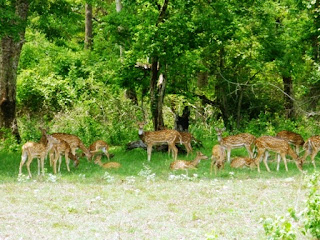Parambikulam was
originally a vast teak forest. The origins can be seen in the Kannimara Teak
tree, one of the largest and oldest teaks in the world 450 year young approx!
Today Parambikulam sanctuary comprises teak, sandal, rosewood and bamboo
 |
| Kannimara Teak Tree |
Today Parambikulam sanctuary comprises teak, sandal, rosewood and bamboo
Wildlife
Wild animals
inhabit the 30 swamps spanning over 150 ha. Inside the forests there are
tigers, elephants, wild dogs, leopards, spotted deer, wild boar, sloth bear,
macaque monkey, langurs, Indian bison (Gaur)
But more often what
can be spotted are spotted deer, lots of them...
wild boar, bison and langurs but it's more of a boar bison territory
wild boar, bison and langurs but it's more of a boar bison territory
There are 140 species
of birds including the black woodpecker, a rare species. There are a flock of
migratory birds as well like civet, chevrotain and pangolin
You can spot the
resplendent peacock
But what you should be visiting the Parambikulam Wildlife Sanctuary for is the sheer greenery...
But what you should be visiting the Parambikulam Wildlife Sanctuary for is the sheer greenery...













